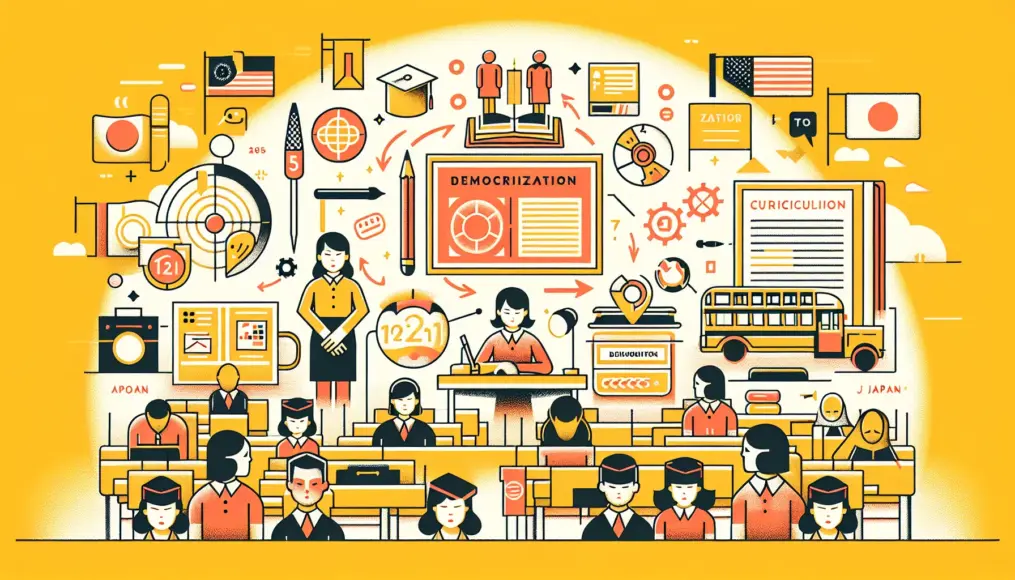After World War II, Japan entered a period marked by profound international changes and a restructuring of its society. During this time, education was recognized as a crucial element for building the nation’s future, prompting significant reforms. The democratization of education and the introduction of new curricula transcended mere learning environments, profoundly influencing the consciousness and values of the population.
This article explores the background of post-war educational reforms and the emergence of a new education system that has driven changes in Japanese society. We will particularly examine the significance of educational equality and the advancements in women’s education, as well as their ongoing impact on today’s educational landscape.
The post-war educational reform was a pivotal turning point in Japan’s history. Understanding its influence can provide valuable insights into the future of education.
- What educational challenges did Japanese society face after the war?
- The social changes brought about by educational equality
- New possibilities opened by advancements in women’s education
The Background of Post-War Educational Reform in Japan
After World War II, Japan was in the process of recovering from the devastation and chaos wrought by the conflict. During this period, the nation faced numerous social challenges, with education emerging as a particularly pressing issue. The disparities in educational quality and access posed a significant threat to the future of the population. It became clear that fundamental educational reform was necessary to address these challenges.
The impact of education on the nation’s revival could not be overstated. By implementing a new educational system, it was hoped that the consciousness of the citizens would shift, simultaneously fostering the overall development of society. In this section, we will delve into the challenges faced by post-war Japanese society and the necessity of educational reform in response.
Challenges in Post-War Japanese Society
In the aftermath of the war, Japan struggled with economic difficulties and social instability. A significant number of children were unable to receive a quality education, and disparities in educational opportunities arose based on regional and familial circumstances. This situation affected the very structure of society and cast a shadow over the nation’s future.
To improve the quality of education, it was essential to create an environment where all children could receive equal educational opportunities. Educational reform was not just about changing systems; it was a crucial process that would lead to a transformation in the collective consciousness of the nation.
- Post-war Japan faced low educational quality and significant disparities
- Educational reform was deemed necessary for social stability and development
- The establishment of an equitable educational environment was imperative
The Necessity of Educational Reform
Educational reform became the key to addressing the social issues confronting post-war Japan. The equalization of education possessed the power to transform the mindset of the entire population, with the potential to contribute to economic development in the future. Moreover, fostering new values through education was viewed as an essential step toward national recovery.
Thus, educational reform was more than just a policy change; it served as the foundation for building the nation’s future. As a result, various reform proposals were put forth and implemented.
For those interested in post-war educational reform, it’s important to understand how shifts in politics and systems influenced education. If you want to explore the changes in the educational system and their background in greater depth, the article “Exploring Japan’s House of Representatives Election System: Its History and Impact” will be insightful. The transformation of the electoral system significantly impacted educational policy, so be sure to check it out.
- Educational reform was seen as the key to solving social problems
- Equal education has the power to change the national consciousness
- The reforms served as a foundation for building the country’s future
The Democratization of Education and Its Impact
In post-war Japan, the democratization of education emerged as a pivotal theme. This reform aimed to provide equal educational opportunities for all children, resulting in significant changes throughout the educational system. Notably, the push for educational equality was expected to transform national consciousness and contribute to the overall development of society. In this section, we will explore how the drive for educational equality and the introduction of a new educational system influenced Japanese society.
The democratization of education did not only bring about changes to the educational framework; it also had a profound effect on the values and social structures of the nation. With the implementation of a new educational system, children gained access to diverse learning environments, allowing them to nurture their individual talents. As a result, education was re-evaluated as a crucial element supporting the very foundation of society.
Educational Equality
Educational equality stands as one of the most significant reforms in post-war Japan. It established that every child has the right to receive an education, regardless of their geographic or economic background. By creating an environment where all children could access education, the first steps were taken toward addressing social disparities.
This commitment to equality not only expanded educational opportunities but also significantly influenced the consciousness and values of the entire population. As education became a norm, people’s aspirations for self-actualization and social participation grew, allowing more individuals to contribute to society.
- The right to education was secured for all children through educational equality.
- Important steps were taken towards addressing social disparities.
- The desire for self-actualization and social participation among citizens increased.
Introduction of a New Educational System
The introduction of a new educational system was a central element of the educational reforms in post-war Japan. This shift transitioned from rote learning to an approach that respects children’s individuality and interests. Specifically, inquiry-based learning and experiential education became focal points, creating environments where children could engage actively in their own learning.
Moreover, the new educational system transformed the relationship between teachers and students. Teachers transitioned from being mere transmitters of knowledge to partners who support children’s learning journeys. This change not only enhanced the quality of education but also fostered the ability of children to think independently and take initiative.
- The new educational system introduced a focus on respecting individuality and interests.
- Inquiry-based learning and experiential education became increasingly emphasized.
- Teachers assumed the role of partners in supporting children’s learning.
The Evolution and Innovation of Curriculum
In the wake of World War II, educational reform in Japan saw significant changes, particularly in the curriculum. Before the war, the focus was largely on rote memorization of knowledge. However, post-war education shifted dramatically towards fostering active learning among students. This transformation led to a fundamental re-evaluation of educational content and methods, resulting in more diverse learning opportunities.
In this section, we will compare the curricula before and after the war, exploring how post-war educational reforms have shaped modern education. The shift in curriculum is not merely about changing what is taught; it also plays a crucial role in shaping national values and societal norms.
Comparing Pre- and Post-War Education
Japan’s educational system before the war was characterized by strictness, primarily aimed at imparting knowledge in a one-sided manner. Students were expected to follow their teachers’ instructions and memorize information, leaving little room for creativity or critical thinking. This educational style resulted in a uniform set of values being instilled across society.
In contrast, the post-war educational reforms brought about a significant overhaul of the curriculum. Emphasizing student agency, new classes were introduced to nurture inquiry and creativity. As a result, education transformed from a mere transfer of knowledge to a dynamic environment where children learn to think for themselves and solve problems.
- Pre-war education focused heavily on rote memorization.
- Post-war reforms introduced a curriculum that emphasizes student agency.
- The purpose of education shifted from knowledge transfer to developing critical thinking.
Impact on Modern Education
The changes in curriculum following the war have had a profound impact on contemporary education. For instance, project-based learning and collaborative learning have gained traction, providing students with more opportunities to tackle challenges as a team. This approach enhances communication skills and problem-solving abilities, making it easier for students to acquire the skills needed in today’s society.
Additionally, there has been a growing emphasis on diversity and international perspectives within educational content. In an increasingly globalized world, the ability to understand different cultures and values is more important than ever, leading to the development of curricula that address these needs. The post-war educational reforms have not only resolved past issues but have also laid a vital foundation for envisioning the future of education.
- Modern education has seen a rise in project-based learning.
- Emphasis is placed on communication and problem-solving skills.
- Curricula now incorporate diversity and international perspectives.
The Advancement of Women’s Education and Its Significance
In post-war Japan, the progress of women’s education brought about significant changes across society. Traditional values were reevaluated, leading to a newfound norm where women receiving education became commonplace, paving the way for their participation in various aspects of society. With expanded educational opportunities, women began to pursue their potential, laying the groundwork for their achievements in diverse fields.
This chapter explores how the advancement of women’s education is intertwined with their societal participation, and how these two factors have influenced each other. It’s crucial to understand that the progress of women’s education not only transforms individual lives but also serves as a significant element that impacts the overall structure of society.
Women’s Participation in Society
After the war, women’s participation in society in Japan saw remarkable progress. As education became more accessible, women gained more opportunities to pursue higher education and enter professional and managerial roles. This shift made women’s participation in economic activities a norm, leading to changes in their roles within the household as well.
Moreover, by receiving education, women developed greater independence and self-esteem, which strengthened their voices in society. This transformation fostered a growing awareness of gender equality, serving as a catalyst for changing societal values. The advancement of women in society became a vital factor not just for economic development, but also for fostering diversity within families and local communities.
- Increased opportunities for women’s higher education post-war
- Women’s participation in economic activities became the norm
- Enhanced independence and self-esteem positively influenced society as a whole
Changes in the Educational Landscape
The advancement of women’s education also brought about significant changes in educational settings. The content and methods of education were reevaluated, leading to the provision of equal education regardless of gender. As a result, female students were given opportunities to study various subjects just like their male counterparts.
Additionally, the increase in female teachers within educational institutions served as role models for female students, promoting a shift in mindset within learning environments. The rise of female educators contributed to greater diversity in the educational landscape, creating a richer learning environment. Thus, the changes in education play a crucial role in supporting women’s participation in society.
- Equal education regardless of gender became standard in educational settings
- Expanded learning opportunities for female students
- The increase in female teachers brought diversity to the educational landscape
Conclusion
The educational reforms in post-war Japan were a crucial process in shaping the country’s future. The democratization of education, changes in the curriculum, and advancements in women’s education played significant roles in transforming the mindset of the nation. Additionally, the push for educational equality provided every child with the opportunity to learn, contributing to the overall development of society. These reforms went beyond merely revising the education system; they profoundly influenced the values and social structure of the populace.
Moreover, the changes in education continue to serve as a vital foundation for exploring new approaches that emphasize diversity and internationalism in modern education. The post-war educational reforms prompted a reevaluation of the significance and role of education, offering important guidelines for contemplating the future of education.
- Post-war educational reforms were a key process in changing the mindset of the nation.
- The push for educational equality ensured that every child had the opportunity to learn.
- Modern education is evolving to prioritize diversity and internationalism.
Reflecting on how these post-war educational reforms have impacted our educational future is essential. We would love to hear your thoughts and opinions, so please share your comments with us!



Comment